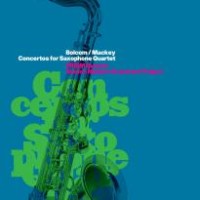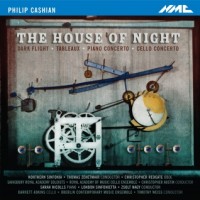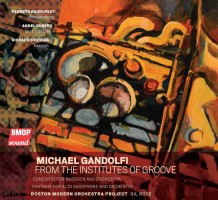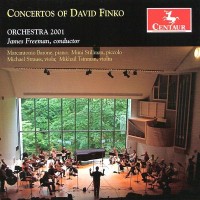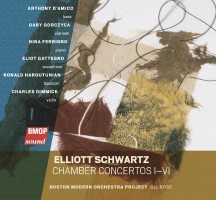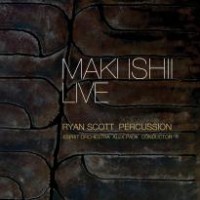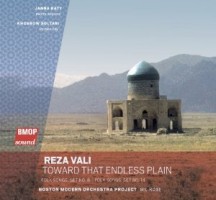Concerto Concentrations 1.
|
Grant Chu Covell [January 2014.]
William BOLCOM: Concerto Grosso (2000). Steven MACKEY: Animal, Vegetable, Mineral (2005). PRISM Quartet: Timothy McAllister, Zachary Shemon, Matthew Levy, Taimur Sullivan (sax), Boston Modern Orchestra Project, Gil Rose (cond.). Innova 731 (1 CD) (http://www.innova.mu/). Of course Bolcom’s Concerto Grosso for saxophone quartet and orchestra is going to be good. Channeling smooth Jean Françaix, perky Leroy Anderson and carnival bebop, the four movements tease and cavort. The last movement, Badinerie, is a rocking, jovial quasi big-band invention. Mackey’s concerto is a tad more serious and conventional despite the movements’ titles: Jackass, Bagpipe and Machine. Who wouldn’t want to hear a movement designated Jackass? I hear more animal in Bagpipe, perhaps because the central movement develops content from the first amongst drones. Even when each composer employs the massed quartet sound PRISM’s four voices are always distinct. This is a deliriously lively release.
Philip CASHIAN: Tableaux (2003)1; Cello Concerto (2012)2; The House of Night (2002)3; Dark Flight (2007)4; Piano Concerto (2006; rev. 2013)5. Northern Sinfonia1, Darrett Adkins2 (vlc), Oberlin Contemporary Music Ensemble2, Christopher Redgate3 (ob), Sainsbury Royal Academy Soloists3, Royal Academy of Music Cello Ensemble4, Sarah Nicolls5 (pno), London Sinfonietta5, Thomas Zehetmair1, Timothy Weiss2, Christopher Austin3,4,5, Zsolt Nagy5 (conds.). NMC D188 (1 CD) (http://www.nmcrec.co.uk). Boldly kinetic music as bricks are made, stacked, and then knocked down. NMC offers three concertos, two explicitly named for cello and piano, and the shorter five-movement The House of Night which places solo oboe over 12 strings. The cello concerto, balancing soloist with strings, launches with pizzicato. The piano concerto is dynamic and arresting. The three-part panel, Tableaux, creates its own steam. Dark Flight is an energetic rhapsody for six cellos. Two conductors appear for the Piano Concerto, not because it requires multiple tempos, but rather that the revised last movement was later recorded.
“From the Institutes of Groove.” Michael GANDOLFI: From the Institutes of Groove (2009)1; Concerto for Bassoon and Orchestra (2009)2; Fantasia for Alto Saxophone and Orchestra (2006)3. Angel Subero1 (b-trb), Richard Svoboda2 (bsn), Kenneth Radnofsky3 (a-sax), Boston Modern Orchestra Project, Gil Rose (cond.). BMOP/sound 1028 (1 SACD) (http://www.bmopsound.org/). These three Gandolfi concertos spotlight less familiar instruments: bass trombone, bassoon and alto-saxophone. The orchestra responds quickly with glittering colors with little introspection in these briskly moving, extroverted essays. Gandolfi dabbles with popular styles: Jazz/rock explicitly for the trombone; the saxophone navigating Purcell, a bolero and mambo. There are moments in the bassoon concerto, as with the Presto finale, which recall Copland’s popular idiom. Gandolfi sports an easy-going language, reflecting bold American minimalism and an admiration for Wagner’s imposing edifices. Excellent work from the soloists: Subero’s velvet agility on an instrument associated with plodding pedals, Svoboda’s supple singing voice in a register often higher than Radnofsky’s husky alto.
David FINKO: Concerto for Viola and Orchestra (1971)1; Concerto for Piano and Orchestra, “Moses” (1971)2; Concerto for Violin and Orchestra (1988)3; Concerto for Piccolo and Orchestra (2006)4. Michael Strauss1 (vla), Mikhail Tsinman3 (vln), Marcantonio Barone3 (pno), Mimi Stillman4 (pic). Orchestra 2001, James Freeman (cond.). Centaur CRC 3226 (1 CD) (http://www.centaurrecords.com/). The viola and piano concertos were written under the long shadow of the Soviet state. The viola concerto portends the “knock at the door” whereas the piano concerto finds strength in retelling Moses’ story. Finko’s concertos employ the long-lost art of call-and-response between soloist and orchestra. Sometimes it’s the patter of love, at others it’s outright bickering. The violin’s reactions are confrontational here, friendly there. Opening with stark pizzicato, the viola concerto offers a vibrant story of terror and survival. It would make a fitting companion to the Schnittke concerto or Shostakovich sonata. Like the violin concerto, the piccolo concerto was written in the United States. Given the instrument’s stridency, battles are more one-sided. The three movements pause and lurch as Finko explores humor and tenderness. The violin and viola concertos are reissues of separate CRI and later New World Records’ discs. The piano and piccolo concertos were recorded in 2009. A foldout booklet shows Finko (b. 1936) in conversation with conductor Freeman.
Elliott SCHWARTZ: Chamber Concerto I (1976)1; Chamber Concerto II (1976)2; Chamber Concerto III, “Another View” (1977; rev. 2007)3; Chamber Concerto IV (1980-81)4; Chamber Concerto V, “Water Music” (1991; rev. 2006-07)5; Chamber Concerto V, “Mr. Jefferson” (2007; rev. 2008)6. Anthony D’Amico1 (cbs), Gary Gorczyca2 (clar), Nina Ferrigno3 (pno), Eliot Gattegno4 (sax), Ronald Haroutunian5 (bsn), Charles Dimmick6 (vln), Boston Modern Orchestra Project, Gil Rose (cond.). BMOP/sound 1013 (1 CD) (http://www.bmopsound.org/). With their rambunctious atonality and impetuous design, Schwartz’s concertos recall a different era, with real and imagined quotations filtering through. There are physical details which loudspeakers cannot convey: In I, players briefly leave their seats to assist in the percussion section and harass the double bass soloist attempting a cadenza. In IV, the solo saxophonist takes a stroll, with, in VI, the orchestral flute joining the harpsichord for an intimate chat. There are also aleatoric moments wherein instruments improvise on a pitch set. An older CRI disc (CD 598) with II and VI plus other solos and duos (some with tapes) offers works of the late 70s and early 80s searching for the future. Flash forward and the same music is both serious and definitive. In the most recent concertos, for bassoon (V) and violin (VI), Schwartz finds greater lucidity, even with larger ensembles.
“Maki Ishii Live.” Maki ISHII: Saidōki (Demon), Op. 86 (1989-92); Concertante, Op. 79 (1988); Percussion Concerto “South – Fire – Summer” Op. 95 (1992). Ryan Scott (perc), Esprit Orchestra, Alex Pauk (cond.). Innova 809 (1 CD) (http://www.innova.mu/). Two invigorating concertos for percussion and orchestra sandwich a relatively effete concertante for marimba. Rich with big gestures, the soloist in Saidōki (Demon) plays what sound like the spokes of a bicycle wheel in addition to bamboo instruments. It’s as if Scott is using otherworldly percussion sounds to escape from the orchestra. Excepting outbursts, South – Fire – Summer keeps the orchestra at bay. This concerto suggests a connection to the earth’s seismic activity. Some may recall the concertante for marimba accompanied by six percussionists as the anticlimactic B-side to the Denon 81757 3678 2 release of Xenakis’ Pléïades (dedicatee Keiko Abe with the Percussions de Strasbourg). In this context it’s interesting to hear the percussionist concentrating on pitches. The title misleads somewhat: These are live CBC Radio recordings recorded on three separate occasions (2009, 2000 and 2008). Ishii died in 2003.
Reza VALI: Folk Songs, Set No. 81 (1989); Folk Songs, Set No. 142 (1999); Concerto for Persian Ney and Orchestra, “Toward that Endless Plain” 3 (2003). Janna Baty1,2 (sop), Khosrow Soltani3 (ney), Boston Modern Orchestra Project, Gil Rose (cond.). BMOP/sound 1026 (1 CD) (http://www.bmopsound.org/). Having studied and taught in Tehran, Vienna and Pittsburgh, Vali, realizing the constraints of Western tuning, now exercises the Persian Dástâgh/Mághâm system and its instruments such as the ney. Varèsian vigor at the opening soon yields to the Persian end-blown bamboo flute whose gentle microtones brush against the orchestra. I suspect that amplification augments the ney’s delicate voice. The music’s uniqueness, style and melodies make it well worth exploring. The Concerto is prefaced with two precisely crafted song cycles for chamber orchestra and soprano. They’re a bit like Szymanowski and Mahler as seen from the Levant, with a bit of Bernstein thrown into the mix. Perhaps Berio’s Folk Songs are the best precedent. Indeed the soprano takes full measure of Berberian’s range and expressive power in these enjoyable song sets.
[Previous Article:
Lying down with Stax phones 1.]
[Next Article:
Snapshots: Miroslav Srnka]
|
